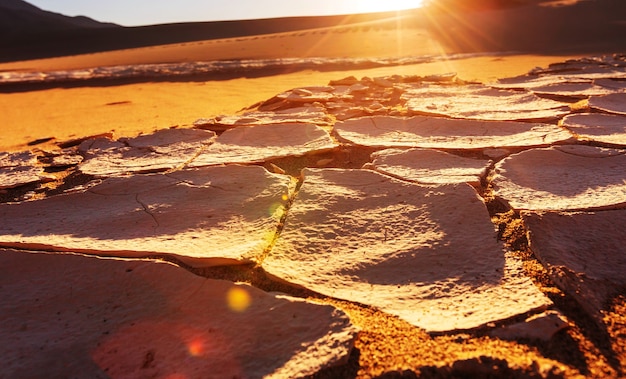Singing Sand Dunes: Unraveling the Eerie Melodies of US Deserts

The mystery of the singing sand dunes in certain US deserts lies in the unique size, shape, and silica composition of the sand grains, which, when disturbed by wind or human activity, create eerie, low-frequency acoustic vibrations that resonate to produce a distinct, often musical, sound.
Have you ever heard a desert sing? In certain corners of the United States, this isn’t just a poetic metaphor. The mystery of the singing sand dunes: why certain US deserts emit eerie melodies, is a fascinating phenomenon that blends geology, physics, and a touch of the surreal.
What are Singing Sand Dunes?
Singing sand dunes, also known as booming dunes or whistling dunes, are a geological phenomenon where large sand dunes emit a low-frequency sound, often described as a hum, whistle, or even a musical tone, when disturbed. This eerie melody isn’t found just anywhere; it requires specific conditions to occur.
The Science Behind the Sound
The sound production hinges on a complex interplay of factors related to the sand itself. The grains need to be of a specific size and composition, as well as relatively uniform. It’s not just any sand that can sing.
- Grain Size: The sand grains are typically between 0.1 and 0.5 millimeters in diameter.
- Composition: The sand is usually composed of silica and must be very well-rounded and smooth.
- Moisture Content: The sand needs to be exceptionally dry for the effect to be pronounced.
The disturbance of the sand, whether by wind, walking, or even a landslide, causes the surface layers to slip. This generates vibrations that, when amplified by the shape and size of the dune, produce the unique sound.
In summary, singing sand dunes are a combination of specific sand properties and environmental conditions that create a unique acoustic phenomenon.

Where Can You Find Singing Sand Dunes in the US?
While not every desert dune sings, the United States is home to several locations where you can experience this phenomenon firsthand. These locations offer both the right type of sand and the environmental conditions necessary for the dunes to “sing.”
Notable Locations
These dunes are scattered across different states, each with its unique characteristics and charm. Here are some places where you can listen for the melodies of the dunes.
- Eureka Dunes, Death Valley National Park, California: These are some of the tallest dunes in North America and are renowned for their booming sounds.
- Great Sand Dunes National Park and Preserve, Colorado: Here, the high altitude and diverse landscape add to the experience of hearing the dunes.
- Sleeping Bear Dunes National Lakeshore, Michigan: Interestingly, singing sand dunes aren’t limited to deserts; they can also be found along certain shorelines.
Each of these locations offers a slightly different experience, influenced by the surrounding environment and the specific characteristics of the dunes themselves. Whether you’re in a stark desert landscape or along a freshwater shoreline, the sound of singing sand is a unique and unforgettable experience.
Ultimately, the location of singing sand dunes depends on a combination of geological and environmental factors, including the type of sand and climate, creating a rare and enchanting acoustic experience.
The Geological Makeup: Sand Composition Matters
The specific composition of the sand plays a pivotal role in whether a dune can sing. It isn’t just about having sand; it’s about having the right kind of sand. The type of minerals, the shape of the grains, and their size all contribute to the acoustic properties of the dunes.
Silica’s Significance
Silica, or silicon dioxide, is the most common component in singing sand. It’s the purity and form of silica that matter most. Well-rounded grains of uniform size made of silica are ideal. The grains need to be free of impurities and have a smooth surface. The homogeneity allows for better contact and slippage when the sand is disturbed, creating the resonant effect.
Ultimately, the specific geological makeup of the sand determines its acoustic properties, with silica composition playing a crucial role in enabling the singing phenomenon.
Environmental Factors: The Role of Climate and Moisture
Beyond the sand itself, environmental conditions, particularly climate and moisture levels, play a crucial role in enabling the singing sand phenomenon. The right conditions are essential for the dunes to produce their characteristic sounds.
The Significance of Dryness
Dryness is key. When sand is wet, the water between the grains acts as a binding agent, preventing the grains from sliding against each other freely. This dampening effect inhibits the vibrations necessary to produce sound.
In summary, arid conditions are vital for maintaining the dryness required for sand grains to slip and vibrate, producing the distinctive sounds of singing dunes.

How Humans Interact with Singing Sand Dunes
Human interactions with singing sand dunes can significantly influence the acoustic experience. From casual exploration to scientific research, our presence can both enhance and threaten these natural soundscapes.
Footsteps and Sound: Amplifying the Melody
One of the most common ways humans interact with the dunes is simply by walking on them. The pressure from footsteps causes the top layers of sand to slide, creating the singing or booming effect. This can be a thrilling experience, as each step generates a unique sound, amplifying the melody of the dunes.
- Controlled Slides: Some visitors intentionally slide down the dunes to create larger, more resonant sounds.
- Group Activity: Large groups walking or sliding together can produce a chorus of sound, making the experience even more dramatic.
- Respectful Interaction: It’s essential to interact respectfully, avoiding actions that could damage the fragile dune ecosystem.
Balancing human interaction with the preservation of these unique acoustic environments is crucial for ensuring that future generations can also experience the eerie melodies of singing sand dunes.
Human interaction with singing sand dunes can enhance the acoustic experience while also posing challenges for conservation.
Preserving the Singing Sand Dunes
Conservation efforts are essential to preserve the delicate balance of these natural wonders. Protecting them ensures that future generations can experience the unique sounds and landscapes of these deserts.
Conservation Strategies
Various strategies can be employed to protect these unique environments, from regulating tourism to implementing scientific research.
The preservation of singing sand dunes requires a combination of awareness, regulation, and continued scientific inquiry.
| Key Aspect | Brief Description |
|---|---|
| 🎶 Sound Mechanism | Vibrations from sand grains slipping cause the “singing” sound. |
| 🏜️ Key Locations | Eureka Dunes (Death Valley), Great Sand Dunes (Colorado). |
| 🔬 Sand Composition | Primarily silica, well-rounded & uniform. |
| 💧 Environmental Role | Dry conditions are essential; moisture inhibits sound. |
Frequently Asked Questions
▼
The singing sound is created by the friction of sand grains sliding against each other. Specific size and composition contribute to the eerie acoustics. The ideal grains need to be nearly uniform as well as dry.
▼
While most are found in deserts, singing sand dunes are not exclusive to these environments. They can also occur in coastal regions, like the Sleeping Bear Dunes in Michigan. This helps create opportunities to listen to dunes sing.
▼
Yes, human activity can influence the sound. Walking, sliding, or even small landslides can cause layers of sand to slip, creating the singing or booming effect. Human interactions must be respectful to protect the sands.
▼
The “singing” depends on specific conditions like grain size, silica composition, and dryness. Factors such as moisture or irregular grain sizes prevent the vibrations needed to produce eerie sounds. These attributes all contribute to the sound.
▼
Conservation efforts often involve controlled access to reduce human impact. Raising awareness about the fragility of these ecosystems and continuous scientific studies also help to preserve the sand dunes. Protecting them protects the sounds.
Conclusion
The mystery of the singing sand dunes is a testament to the intricate interplay of geology, environment, and acoustics. These unique desert formations offer a symphony of natural sounds, inviting us to appreciate and protect these fragile wonders for generations to come.